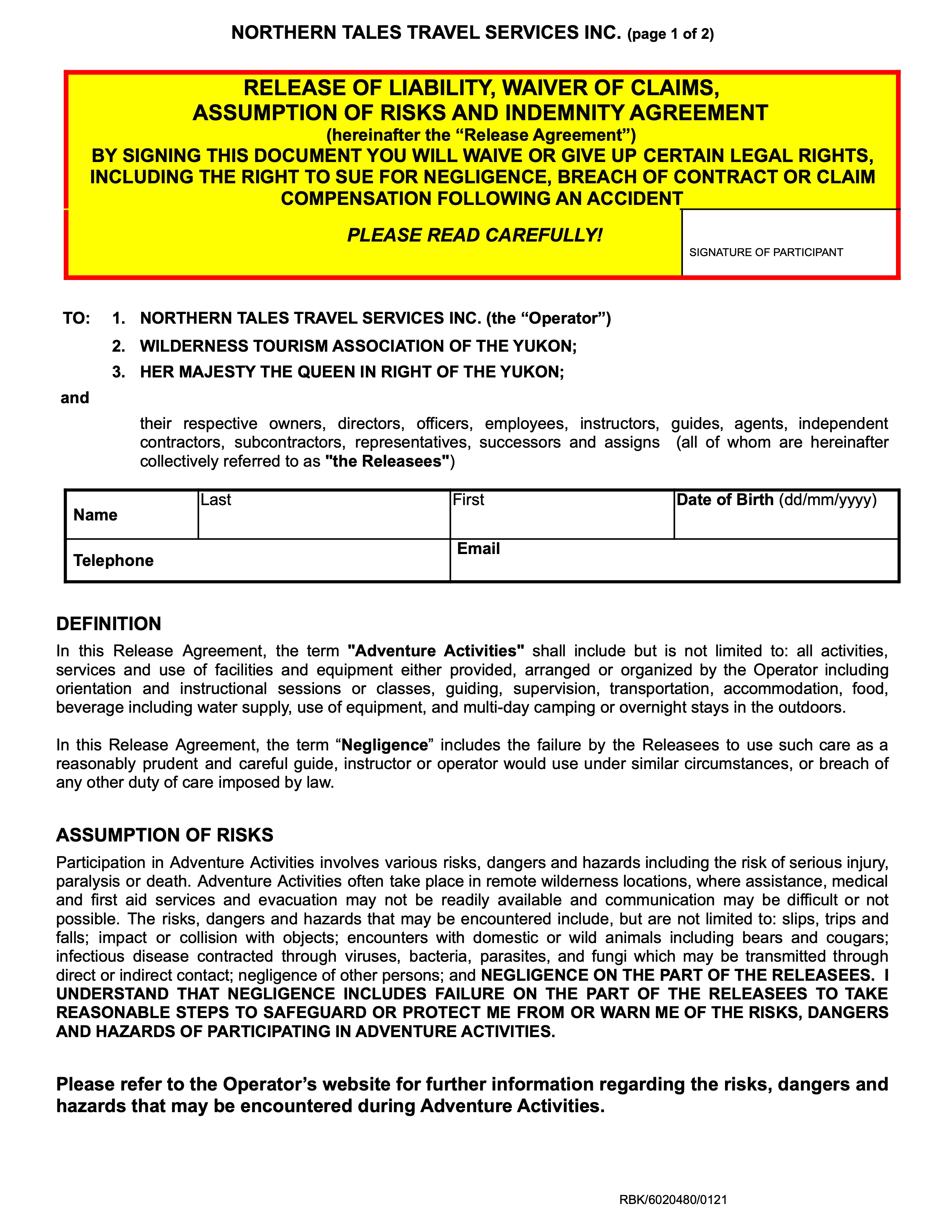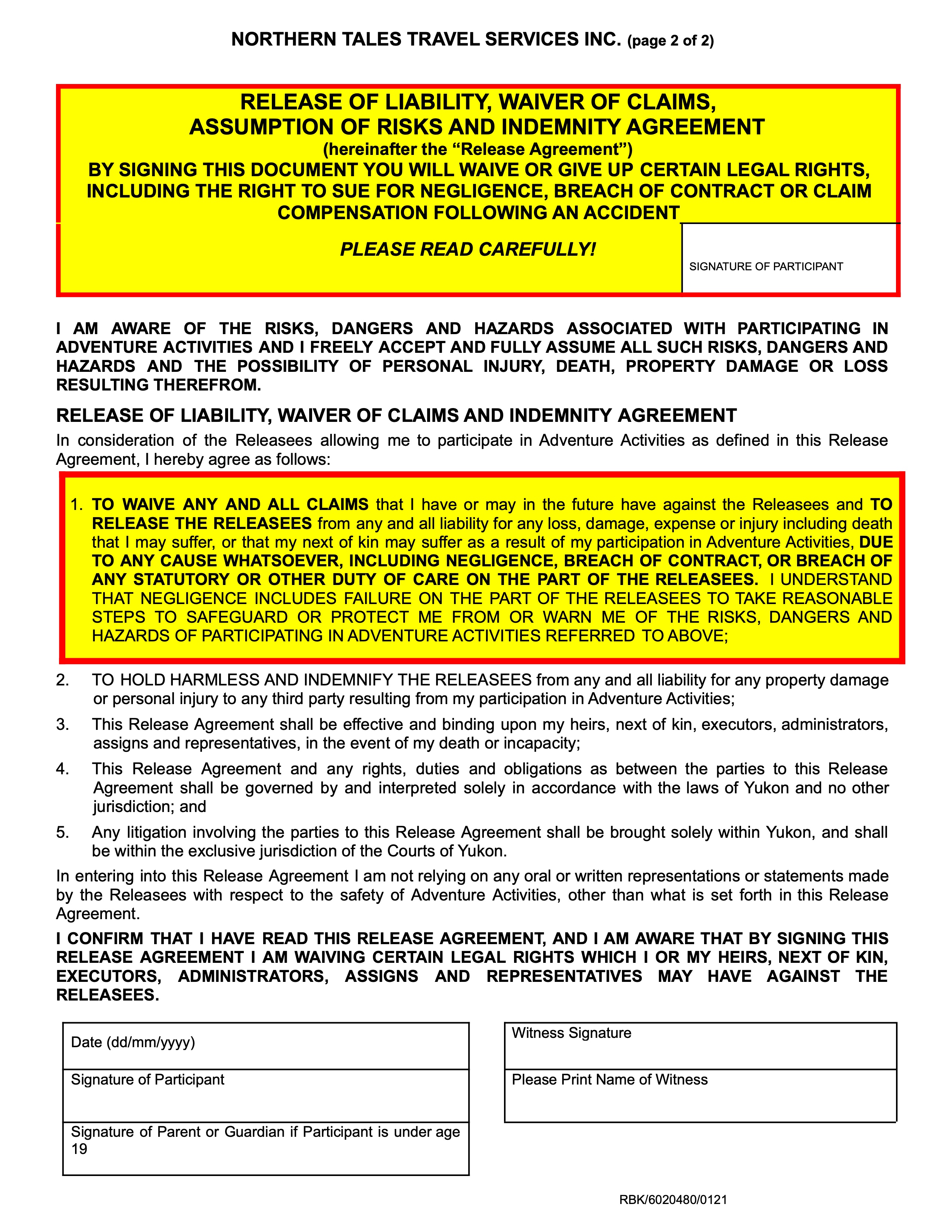

Dog Sledding – Participating in backcountry/arctic travel, skiing, snowshoeing, Nordic skiing & dogsledding involves additional and specific risks, dangers and hazards of travelling in rugged alpine, backcountry or wilderness environments, including but not limited to: avalanches; changing weather conditions; exposed rock, earth, ice and other natural objects; trees, tree wells, tree stumps and forest deadfall; the condition of snow or ice on or beneath the surface; variations in the terrain which may create blind spots or areas of reduced visibility; variations in the surface or sub-surface; variable and difficult snow conditions; streams, creeks and exposed holes in the snowpack above streams or creeks; rocks, boulders, crevasses, cliffs, gullies and ravines; snowcat roads, road-banks or cut-banks; collision with natural or man-made objects adjacent to or on the trails; snow immersion; impact or collision with other dog sleds; violent and unexpected forces and movement which may aggravate previous injuries; dog bites; overturning of the sled; breakdown or failure of equipment; failure to act safely or within one’s own ability.
Snowshoeing – Participating in hiking, snowshoeing, backpacking and backcountry travel involves additional and specific risks, dangers and hazards including but not limited to: travel over extreme, mountainous or alpine terrain where fallen timber, branches, rocks, roots or other obstacles or hazards, steep slopes or unstable ground may cause falls; avalanches; travel on, through or beside snowfields, glaciers, crevasses, streams, creeks, rivers, ponds and lakes; miscellaneous health problems related to over-exposure to the sun, dehydration, food poisoning, insect bites, fatigue, stress, exertion, high altitude and lack of fitness; snow immersion; encounters with domestic animals including dogs, and wildlife, including bears and cougars; encounters with dangerous or poisonous flora and fauna; becoming lost or separated from one’s party or guide; slips, trips and falls; negligence of other person; negligent first aid.
Snowmobiling – Participating in snowmobiling, ATV Tour whether as operator of the vehicle or as a passenger, involves risks, dangers and hazards including, but not limited to: changing weather conditions and visibility; mechanical failure of the equipment; failure to control the speed or direction, stopping distances and turning radius of the vehicle; loss of balance; rolling or flipping the vehicles; changes or variation in the terrain used for the tour which may create blind spots or areas of reduced visibility; collision with other vehicles, equipment, structures, objects or persons; collision with exposed rock, snow, ice, earth, trees, tree wells, tree stumps, forest deadfall or other natural or man-made objects; avalanches; encounters with wildlife, including bears and cougars; travel on back-country roads and trails; becoming lost or separated from the guides, instructors or other participants; slips, trips and falls; failing to act safely or within one’s own ability or remain within designated areas; negligence of other persons.
Ice Fishing – Ice Fishing involves risks, dangers, and hazards which are not limited to: slips, trips and falls; falling through the ice; changing weather; changing temperatures; drowning; hypothermia; exposure to water and sun; hidden and submerged objects; negligence of other persons.
Canoeing – Participating in Water Activities involves many risks, dangers and hazards including but not limited to: slips, trips and falls; falling off kayaks, canoes or paddle boards; changing weather; high wind; lightning; impact or collision with other vessels or objects in the water, other watercraft, rocks, trees, logs, deadfall, docks or shore walls; strain on joints, neck or spine; overturning or upsetting of kayaks, canoes or paddle boards; entrapment by trees, logs, or equipment; drowning; hypothermia; exposure to water and sun; exposure to infectious disease contracted through viruses, bacteria, parasites, and fungi which may be transmitted through direct or indirect contact; and negligence of other persons.
For each activity you will need to sign a RELEASE OF LIABILITY AND WAIVER AGREEMENT – please find below a sample waiver. Each waiver may vary depending on the operator. Feel free to reach out to us if you have any questions.

